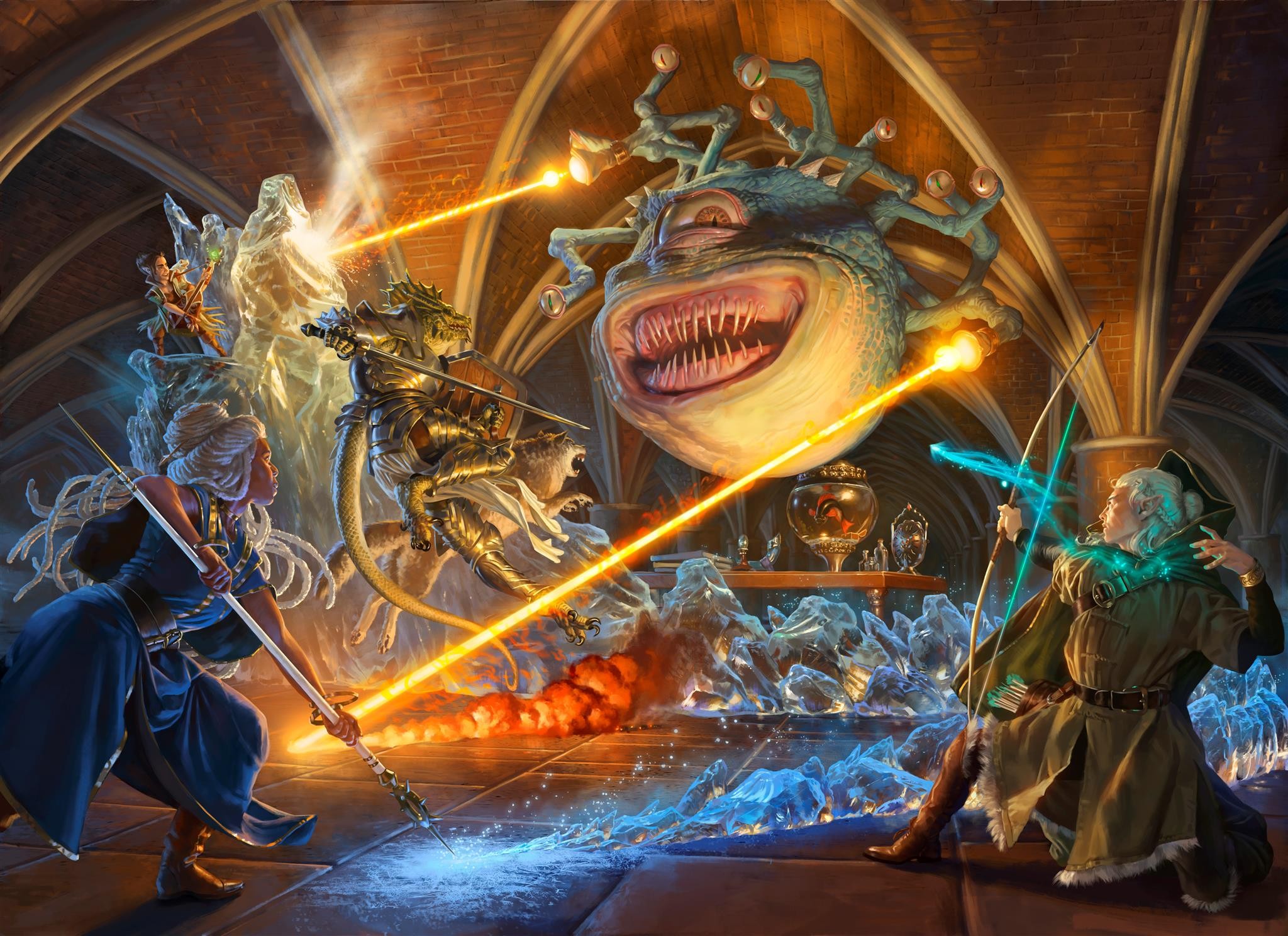Dungeons & Dragons (D&D), the tabletop role-playing game that started it all, emerged in 1974 and has since sparked countless adventures and influenced the video game landscape. From inspiring actual play formats like Dimension 20, The Adventure Zone, and Critical Role (and its animated series The Legend of Vox Machina) to shaping the narrative of Netflix’s Stranger Things and the novel Ready Player One, D&D’s impact is undeniable, even extending to the silver screen with Dungeons & Dragons: Honor Among Thieves.
While these stories showcase the magic of collaborative storytelling, the best way to understand the allure of D&D is to play it yourself. The game’s extensive history and rulebooks may seem daunting, but its enduring popularity means jumping into your own adventure is easier than ever. This guide will provide you with everything you need to get started.
Assemble Your Adventuring Party
Key art from the Magic: The Gathering crossover, depicting a D&D party confronting a beholder.
The first step is finding fellow adventurers. Most players will create player characters (PCs), each with unique abilities, motivations, and backstories that drive their decisions. An ideal group size is typically four to five players, though you can modify encounters to accommodate more or fewer.
One person will take on the critical role of the Dungeon Master (DM). The DM acts as the game’s narrator, rules adjudicator, and voice of all non-player characters (NPCs) – from helpful merchants to fearsome monsters. While you can dive straight into DMing, it’s often beneficial to experience D&D as a player first to better understand the game’s flow and mechanics.
Finding Your Table: In-Person or Online
While gathering around a physical table is a classic D&D experience, it’s not always feasible. Fortunately, many resources make finding a game easier than ever. Wizards of the Coast provides an event locator to find local game stores hosting D&D sessions. Platforms like StartPlaying connect players with professional game masters for paid games.
Remote play has also exploded in popularity, thanks to virtual tabletops (VTTs). VTTs like Roll20, Foundry, Fantasy Grounds, and One More Multiverse offer digital maps, dice, and character sheets, making remote play seamless. Simple video conferencing tools like Google Meet or Zoom can also work in a pinch.
Session Zero: Setting the Stage for Adventure
Before embarking on your campaign, hold a “session zero” to ensure everyone is on the same page. The most important rule of D&D is that everyone has a good time. Using safety tools, like John Stavropoulos’ X-Card, can help players express discomfort during the game. The lines-and-veils system (from Ron Edwards’ Sex and Sorcery) allows the group to set boundaries on potentially sensitive topics.
Character creation also plays a key role in enjoyment. Consider each player’s preferences when choosing classes and backgrounds. A shy player may not enjoy playing a flamboyant bard, while a newcomer might find a fighter easier to manage than a spellcaster. You can use pre-generated characters to get started quickly, or use the official D&D Beyond toolset.
Remember, the DM is not an adversary. Your role is to create engaging challenges that match the players’ level and experience. Be prepared to improvise when dice rolls lead to unexpected outcomes. Embrace the “Yes, and…” principle of improv, accepting player choices and incorporating them into the story.
The Yawning Portal tavern, beautifully rendered by WizKids, highlighting the immersive potential of D&D terrain.
Essential Adventuring Tools
Whether playing in person or online, you don’t need much to get started. While some players invest heavily in props, a pencil, paper, and a set of polyhedral dice are sufficient. You can also find the basic rules online for free.
If you’re running the game, consider the Dungeons & Dragons Starter Set: Dragons of Stormwreck Isle, which provides everything you need for a starting adventure, including pre-made characters, a rulebook, dice, and an adventure book. The Dungeons & Dragons Essentials Kit adds rules for “sidekick” characters, ideal for smaller groups.
For a more comprehensive experience, invest in the Player’s Handbook, Dungeon Master’s Guide, and Monster Manual, available as a slipcase set. To add more encounters and adventures, explore official anthologies like Journeys Through the Radiant Citadel, Candlekeep Mysteries, and Keys From the Golden Vault.
The Dungeon Masters Guild provides a vast library of community-created content, including adventures, maps, and character options.
Pace yourself and pay attention to player engagement. Published campaigns can last months or years. Due to the upcoming One D&D in 2024 rules refresh, avoid over-investing in books for now.
Exploring Beyond D&D: Alternative RPGs
While D&D reigns supreme, numerous other tabletop RPGs offer unique experiences.
If you prefer social interaction and roleplaying over tactical combat, try Thirsty Sword Lesbians, which uses the streamlined Powered by the Apocalypse system. This opens the door to games inspired by Buffy: The Vampire Slayer and Untitled Goose Game.
Books offering great alternatives to D&D, including Thirsty Sword Lesbians and For the Queen.
Blades in the Dark requires minimal preparation, focusing on improvisation in a dark fantasy setting. For a quick start, For the Queen is a card-based storytelling game for collaborative worldbuilding.
Ultimately, the magic of role-playing lies in the shared stories and memorable characters created along the way. So gather your friends, roll the dice, and embark on an unforgettable adventure!
